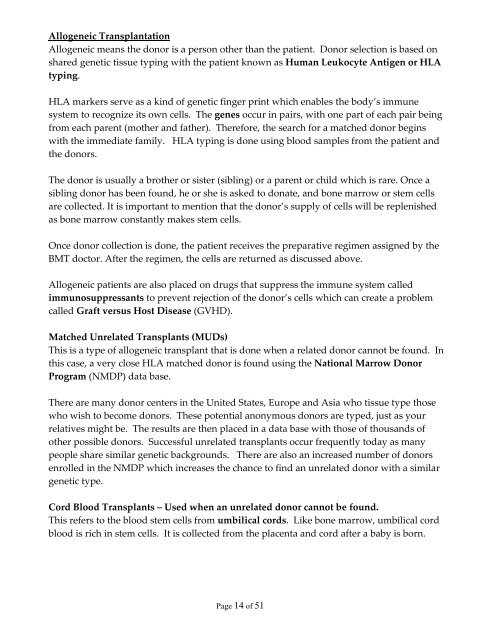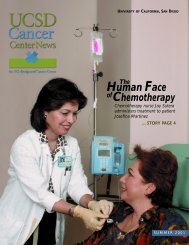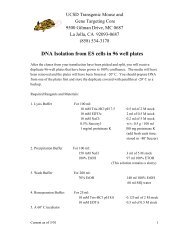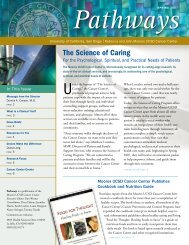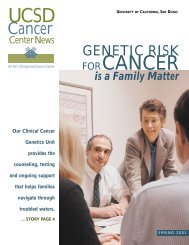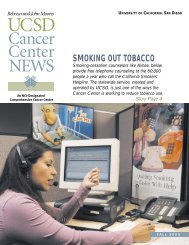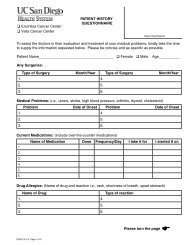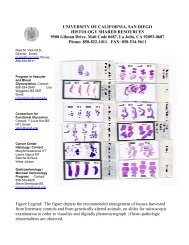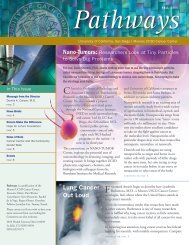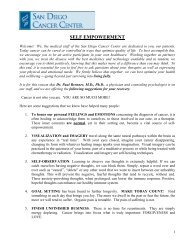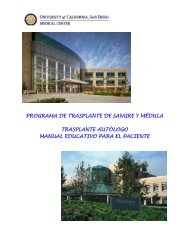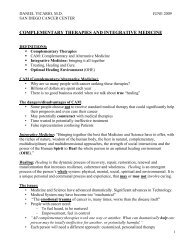Autologous Transplant Patient Education Manual - Moores Cancer ...
Autologous Transplant Patient Education Manual - Moores Cancer ...
Autologous Transplant Patient Education Manual - Moores Cancer ...
You also want an ePaper? Increase the reach of your titles
YUMPU automatically turns print PDFs into web optimized ePapers that Google loves.
Allogeneic <strong>Transplant</strong>ation<br />
Allogeneic means the donor is a person other than the patient. Donor selection is based on<br />
shared genetic tissue typing with the patient known as Human Leukocyte Antigen or HLA<br />
typing.<br />
HLA markers serve as a kind of genetic finger print which enables the body’s immune<br />
system to recognize its own cells. The genes occur in pairs, with one part of each pair being<br />
from each parent (mother and father). Therefore, the search for a matched donor begins<br />
with the immediate family. HLA typing is done using blood samples from the patient and<br />
the donors.<br />
The donor is usually a brother or sister (sibling) or a parent or child which is rare. Once a<br />
sibling donor has been found, he or she is asked to donate, and bone marrow or stem cells<br />
are collected. It is important to mention that the donor’s supply of cells will be replenished<br />
as bone marrow constantly makes stem cells.<br />
Once donor collection is done, the patient receives the preparative regimen assigned by the<br />
BMT doctor. After the regimen, the cells are returned as discussed above.<br />
Allogeneic patients are also placed on drugs that suppress the immune system called<br />
immunosuppressants to prevent rejection of the donor’s cells which can create a problem<br />
called Graft versus Host Disease (GVHD).<br />
Matched Unrelated <strong>Transplant</strong>s (MUDs)<br />
This is a type of allogeneic transplant that is done when a related donor cannot be found. In<br />
this case, a very close HLA matched donor is found using the National Marrow Donor<br />
Program (NMDP) data base.<br />
There are many donor centers in the United States, Europe and Asia who tissue type those<br />
who wish to become donors. These potential anonymous donors are typed, just as your<br />
relatives might be. The results are then placed in a data base with those of thousands of<br />
other possible donors. Successful unrelated transplants occur frequently today as many<br />
people share similar genetic backgrounds. There are also an increased number of donors<br />
enrolled in the NMDP which increases the chance to find an unrelated donor with a similar<br />
genetic type.<br />
Cord Blood <strong>Transplant</strong>s – Used when an unrelated donor cannot be found.<br />
This refers to the blood stem cells from umbilical cords. Like bone marrow, umbilical cord<br />
blood is rich in stem cells. It is collected from the placenta and cord after a baby is born.<br />
Page 14 of 51


